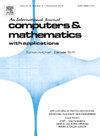Integral transform technique for determining stress intensity factor in wave propagation through functionally graded piezoelectric-viscoelastic structure
IF 2.9
2区 数学
Q1 MATHEMATICS, APPLIED
引用次数: 0
Abstract
This study employs an integral transform approach for Love wave propagation in a rotating composite structure having an interfacial crack. The structure comprises an initially stressed functionally graded piezoelectric-viscoelastic half-space bonded to a piezoelectric-viscoelastic half-space, and is subjected to anti-plane mechanical loading and in-plane electrical loading. The study focuses on two material systems: the first material system consists of Epoxy-BNKLBT and Epoxy-KNLNTS, where BNKLBT stands for , and KNLNTS represents , doped with and . The second material system has Epoxy-BNKLBT and Epoxy-PZT7A, where PZT7A denotes Lead Zirconate Titanate. The viscoelastic materials are modeled to reflect their complex behavior under rotational and stress conditions. The Galilean transformation is applied to convert the Cartesian coordinate system into a moving reference frame aligned with the Love wave's propagation. Employing Bessel function properties, the system is converted into a set of double integral equations and subsequently reformulated into simultaneous Fredholm integral equations. Numerical solutions to these Fredholm integral equations are employed to compute the electric displacement intensity factor and the stress intensity factor near the interfacial crack. These factors are also used to derive the expression for the energy density factor, thereby demonstrating the intrinsic coupling between the stress intensity factor and the electric displacement intensity factor. The key objective of this study is to visualize the impact of different material parameters, including piezoelectric constants, dielectric constants, initial stress, electric displacement at the interface, as well as interface stress and rotation on the stress intensity, electric displacement intensity, and energy density factors. The investigations of this study will be helpful for advanced technologies like surface acoustic wave sensors and piezoelectric actuators, as well as to enhance surface acoustic wave bio-sensor sensitivity and stability for early cancer detection and biomedical implants.
求助全文
约1分钟内获得全文
求助全文
来源期刊

Computers & Mathematics with Applications
工程技术-计算机:跨学科应用
CiteScore
5.10
自引率
10.30%
发文量
396
审稿时长
9.9 weeks
期刊介绍:
Computers & Mathematics with Applications provides a medium of exchange for those engaged in fields contributing to building successful simulations for science and engineering using Partial Differential Equations (PDEs).
 求助内容:
求助内容: 应助结果提醒方式:
应助结果提醒方式:


